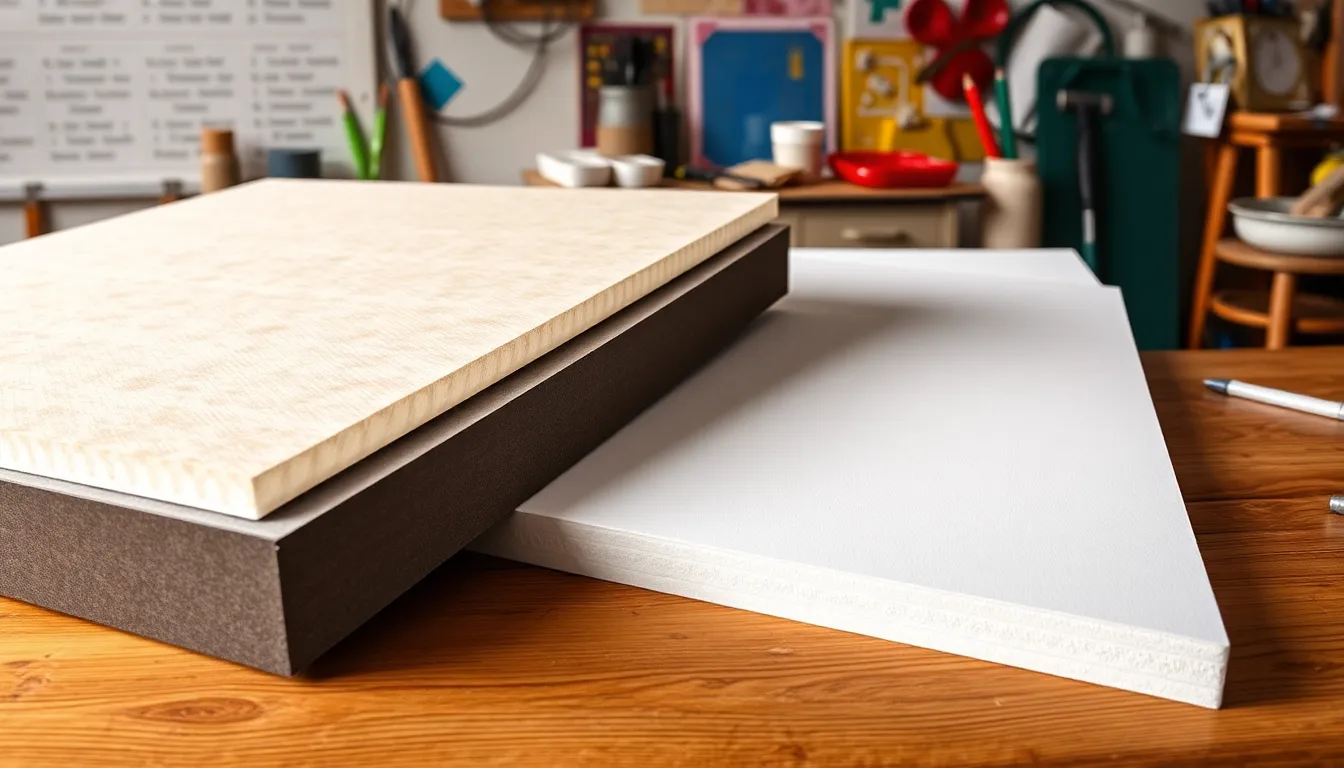When it comes to crafting, presentation, or signage, choosing the right board can make all the difference. Gator board and foam board are two popular options, each with unique properties that cater to different needs. Understanding their differences can help in selecting the best material for a project.
Gator board, known for its rigid structure and durability, often stands out in professional settings. On the other hand, foam board offers a lightweight and cost-effective solution, making it a favorite for students and hobbyists. By exploring the strengths and weaknesses of both materials, one can make an informed choice that ensures the success of their creative endeavors.
Table of Contents
ToggleOverview of Gator Board and Foam Board
Gator board and foam board offer distinct features important for various projects. Gator board consists of a dense polystyrene core with a layer of wood-fiber veneer on each side. This construction provides superior rigidity and scratch resistance. Gator board is commonly used for professional presentations, signage, and displays due to its durability and ability to resist warping.
Foam board, on the other hand, has a lightweight polystyrene foam core sandwiched between two sheets of paper or plastic. This design makes foam board easy to cut and shape, ideal for students and hobbyists. Foam board is more affordable and widely available, catering to a variety of craft and educational projects.
Gator board excels in durability and professional applications, while foam board is favored for its lightweight and cost-effective qualities. Understanding these differences aids in selecting the right board for specific needs.
Comparison of Materials

Gator board and foam board each offer distinct compositions that influence their applications and performance. Understanding the materials helps in selecting the right option for specific needs.
Composition of Gator Board
Gator board consists of a dense polystyrene core sandwiched between two layers of wood-fiber veneer. This design gives it superior rigidity and scratch resistance. The wood-fiber surface not only enhances durability but also provides a professional finish suitable for signage and presentations. Gator board’s robust construction makes it resistant to warping, ensuring longevity in various applications.
Composition of Foam Board
Foam board features a lightweight polystyrene foam core encased in sheets of paper or plastic. This combination allows for easy cutting and shaping, making foam board ideal for student projects and craft applications. The paper or plastic surfaces can be printed on or painted, adding versatility for creative designs. The lighter weight of foam board makes it easier to transport, though it is less durable compared to Gator board.
Durability and Strength
Durability and strength are critical factors when choosing between Gator board and foam board. Understanding each material’s properties helps inform decisions for specific applications.
Gator Board Durability
Gator board features a dense polystyrene core sandwiched between wood-fiber veneers, which enhances its overall durability. Its robust construction resists warping and bending, making it suitable for environments requiring stability over time. Gator board withstands impact better than many alternatives, ensuring it maintains its shape and integrity during transport and display. This resistance to damage makes it an excellent choice for professional presentations and long-term signage, where reliability is essential.
Foam Board Durability
Foam board consists of a lightweight polystyrene foam core covered by sheets of paper or plastic. While it’s easy to cut and shape, foam board lacks the structural strength of Gator board. Foam board is prone to dents and damage from pressure or impact, making it less suitable for high-traffic or demanding environments. However, its versatility allows for creative projects that require light use, such as temporary displays and school presentations, where durability may not be a primary concern.
Weight and Portability
Weight significantly affects the portability of Gator board and foam board, making it crucial for users to consider their specific needs.
Gator Board Weight
Gator board typically features a higher density, making it heavier than foam board. On average, Gator board weighs about 2.5 to 3.5 pounds for a 24”x36” sheet, depending on thickness. This weight contributes to its stability, but it can make transportation more challenging. Its sturdy composition often requires additional support when moved, particularly for larger sizes, making it less convenient for casual users or mobile projects.
Foam Board Weight
Foam board is notably lighter, averaging around 1 to 1.5 pounds for a 24”x36” sheet. This lightweight nature allows for easy handling and transportation, appealing to students and hobbyists. Its portability makes foam board a preferred option for temporary displays or projects requiring frequent relocation. However, the trade-off for this lightweight benefit lies in its reduced durability and susceptibility to damage in transit.
Cost and Affordability
Cost differences between Gator board and foam board significantly influence purchasing decisions. Gator board typically costs between $20 and $40 per sheet, largely due to its durable construction and professional-grade quality. This higher cost reflects its suitability for long-term use in commercial environments, making it a cost-effective investment for businesses that prioritize durability.
Foam board, on the other hand, offers a more budget-friendly option, with prices ranging from $5 to $15 per sheet. This affordability makes foam board a popular choice among students, hobbyists, and those involved in temporary projects. The lower price aligns with its lightweight material and suitability for short-term applications.
While Gator board presents a higher upfront cost, it provides long-lasting value. Its durability ensures fewer replacements and repairs, which can lead to overall cost savings for users engaged in frequent display requirements. Conversely, although foam board is economical initially, frequent replacements may add up over time if used in high-traffic situations.
Purchasing decisions often depend on budget constraints and intended use. For projects requiring longevity and professionalism, Gator board stands out as a worthwhile investment. In contrast, those focused on temporary displays or projects with limited resources may find foam board more appealing. Understanding cost and affordability helps users make informed choices aligned with their specific needs.
Applications and Uses
Both Gator board and foam board serve various applications within crafting, presentation, and signage, catering to distinct needs based on their properties.
Ideal Uses for Gator Board
- Professional Signage: Gator board’s rigidity supports outdoor and indoor signs. Its durability withstands environmental factors, ensuring longevity.
- Trade Shows: Gator board works well for displays and presentations at trade shows. Its professional appearance enhances brand visibility without warping.
- Photography and Art Displays: Gator board serves as a backing material for framed prints or photographs. Its flat surface provides stability and prevents curling over time.
- Architectural Models: Gator board’s strength accommodates precision when building scale models. It holds detailed cuts and complex designs effectively.
Ideal Uses for Foam Board
- Educational Projects: Foam board suits classroom assignments and science fairs. Its lightweight nature facilitates easy manipulation for students.
- Crafting and DIY Projects: Foam board works well for home crafts and creative activities. Its affordability allows for experimentation without significant financial investment.
- Temporary Displays: Foam board serves well for short-term signage, such as event promotions. Its easier transport helps meet the needs of flexible set-up and take-down.
- Framing and Mounting: Foam board can mount artwork for casual displays. Its lightweight design simplifies hanging, making it ideal for home decor.
Choosing between Gator board and foam board ultimately depends on specific project requirements. For professionals needing durability and longevity Gator board stands out as the superior choice. Its robust construction ensures it can withstand the rigors of frequent use while maintaining a polished appearance.
On the other hand foam board offers a lightweight and budget-friendly option perfect for students and hobbyists. Its versatility makes it ideal for temporary projects and creative endeavors. Understanding the strengths and limitations of each material allows users to select the right board for their needs ensuring successful outcomes in crafting and presentation.



